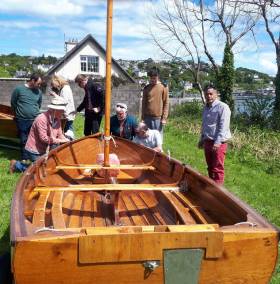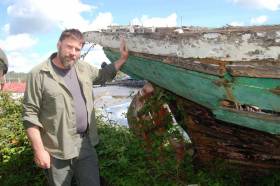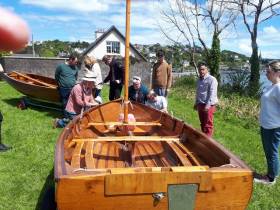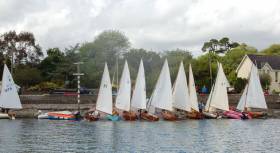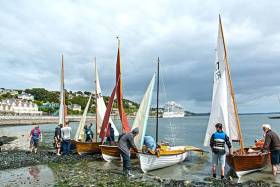Displaying items by tag: Rankin
A New Cork Harbour Rankin Dinghy is Born 61 Years Later
Sixty-one years after the first Rankin came off a mould in Cobh, a new one has been built from the same mould.
"From the roots of this revered dinghy class in Cork Harbour, a new boat has been built," the Class announced.
This is part of the rebuild and restoration project through which Rankin enthusiasts have rekindled interest in the class.
The roots of the Rankins are to be found in the mid-1950s when Eddie Twomey and Eric Rankin produced the line drawings of the Rankin prototype. The first two prototype boats were built in July 1956 in Eric's workshop on Lynch's Quay, Cobh.
They were an integral part of the RCYC when it was based in Cobh. The boats proved extremely popular. Their light construction made them easy to handle and "effortless to row, motor or sail, so they were an ideal family boat for Cork Harbour conditions," the Rankin enthusiasts say. When the RCYC club moved to Crosshaven, "they became a choice mode of river transport, for commuting ashore long before the days of RIBs and the club marina was built," according to one of the leaders of the revival, Conor English in Crosshaven.
Like other dinghy classes over the years, collective sightings of Rankins sailing in Cork Harbour became a rare sight, but in 2014 a group of like-minded enthusiasts from Crosshaven, Cobh and Monkstown came together to see what could be done to revive interest in the Rankins.
Conor and Maurice Kidney in Cobh drove the revival strongly and garnered strong support. "They are a great boat and the support we've got since we started has been tremendous."
 Plank 14 (the Whiskey plank) is fitted to the new Rankin dinghy Photo: Rankin Class Association
Plank 14 (the Whiskey plank) is fitted to the new Rankin dinghy Photo: Rankin Class Association
The result has been a big revival, which we've been following on Afloat and which has led to racing in Cove SC events, participation in the Traditional Sails events in the harbour and the Rankin ''World'' Championships as part of Cork Dinghy Fest in which 21 raced.
Altogether the revival has identified over 40 Rankins.
The new Rankin is a further step, built by Owen O'Connell in the workshop of his brother, Bud and with Dave O'Keeffe, the trio have been working on this 'lockdown' project for the past few months.
On this week's Podcast, Owen O'Connell tells me about the building of the new Rankin and that it is intended to have it on the water in May.
RCYC Dinghy Fest 2019 Saw Biggest Ever Rankin Fleet
A tremendous welcome was extended to the Rankin Dinghy Class by Royal Cork Yacht Club last weekend at its DinghyFest Regatta.
The largest fleet of Rankins ever gathered for the event. 21 boats assembled in the dinghy park, with 20 taking part in the racing.
This turned out to be the biggest participation from any dinghy fleet entered in the event.
 A contrast in styles as Rankins sail with other dinghy classes at DinghyFest Photo: Bob Bateman
A contrast in styles as Rankins sail with other dinghy classes at DinghyFest Photo: Bob Bateman
A sincere thank you to the boat owners who made this such a successful weekend.
A special mention must go to those who for various reasons could not sail their boats and handed them over to other sailors. Tom Dwyer, Ruari Allen, David Doyle, Dominic Losty, the Scott family and Damien Aherne showed this generosity which boosted the numbers and gave others the experience of sailing these lovely boats.
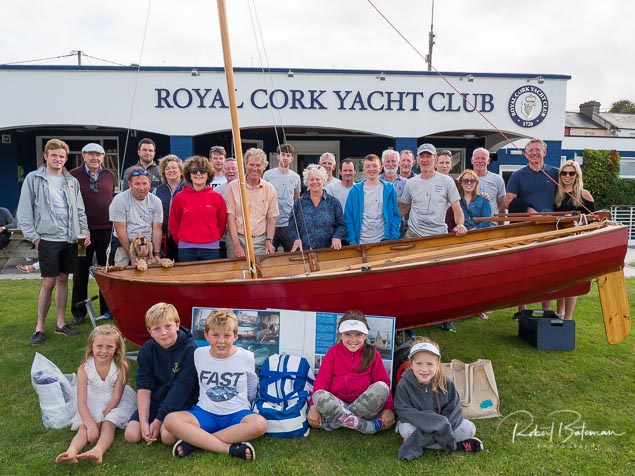 Rankin owners and participants
Rankin owners and participants
The two days sailing were a joy with beautiful weather and racing conditions.
Saturday racing comprised of three races, sailed on the Curlane bank, at the back of Spike.
The fleet seemed to enjoy the competitive aspect of the racing regardless of their experience or boat condition.
After Saturday's results had been tabulated Conor and Robbie English were in Pole position with Ewan O Keeffe, The Cliodhna, The Helga and a number of others in hot pursuit.
 Dave O’Keefe with son Ewan Photo: Bob Bateman
Dave O’Keefe with son Ewan Photo: Bob Bateman
Sunday's racing involved two races sailed in a beautiful breeze, once it filled in from the west.
A race on the Curlane bank was followed by our last race of the weekend. This comprised of a race around a few cans, with an upriver finish off the Marina at RCYC.
 Owen O’Connell and Mike O’Callaghan sailing Helga sailing one of the earlier cold moulded RankinsHelga sailing one of the earlier cold moulded Rankins Photo: Bob Bateman
Owen O’Connell and Mike O’Callaghan sailing Helga sailing one of the earlier cold moulded RankinsHelga sailing one of the earlier cold moulded Rankins Photo: Bob Bateman
This was a great bit of racing with Rankins going nip and tuck into a flukey headwind to finish at the clubhouse.
Overall results more or less followed Saturday's form so a huge congratulations to the English brothers who are the official 2019 Rankin World Champions. Their father Joe, who himself had a great love of the Rankin boat, would be very proud.
Ewan O Keeffe, crewed by his dad Dave was a good second with Maurice Kidney, crewed by Stephen Barry given third based on a countback with Daniel O'
Connell sailing the Cliodhna.
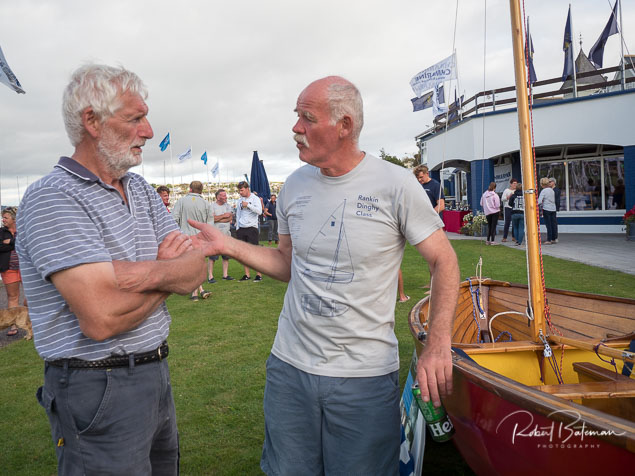 Discussing the finer points of Rankin Build Quality are John Doyle and Owen O’Connell Photo: Bob Bateman
Discussing the finer points of Rankin Build Quality are John Doyle and Owen O’Connell Photo: Bob Bateman
To add to the fun and commitment of the English family, April English, crewing for Mark Bushe on Tom Dwyer's Rankin, both sailed and swam during the
race series. Well done April.
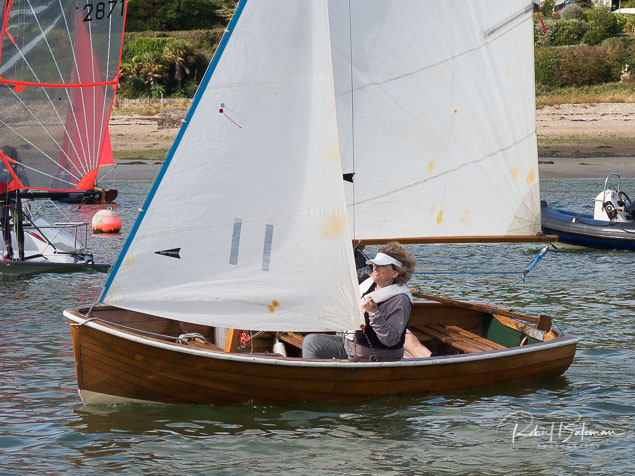 April English keeps a watchful eye out sailing in the Harbour race with Mark Bushe Photo: Bob Bateman
April English keeps a watchful eye out sailing in the Harbour race with Mark Bushe Photo: Bob Bateman
Outside of the official prize-giving, a number of presentations were made within the group.
Sienna Mills got an award for being the youngest participant.
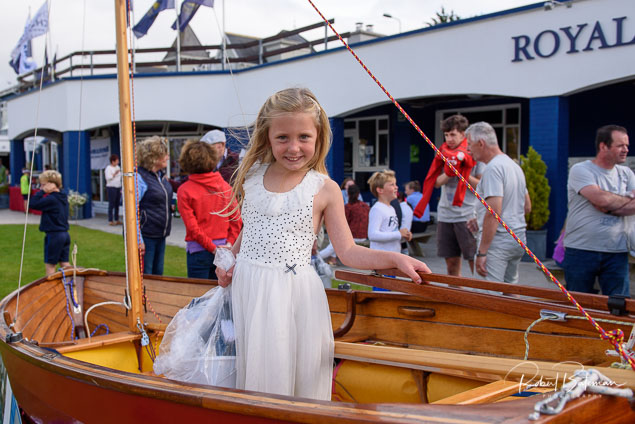 Sienna Mills, the youngest Rankin competitor Photo: Bob Bateman
Sienna Mills, the youngest Rankin competitor Photo: Bob Bateman
Elaine Moynihan and Fiona O'Connell sailing KevDec got best placed female crew and the Scott family got an award for the most travelled boat.
James and Fionn Burke were the deserving winner of the 2019 Rankin Spirit award for their unfailing enthusiasm and commitment to Class activities
since it's formation in 2014.
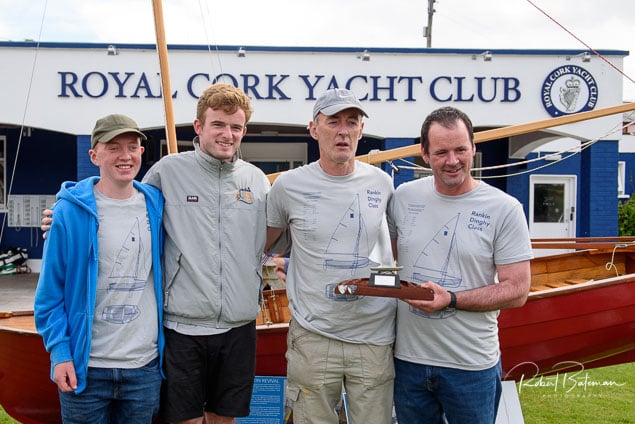 James and Fionn Burke winners of “The Rankin Spirit Award” with Conor English and Maurice Kidney
James and Fionn Burke winners of “The Rankin Spirit Award” with Conor English and Maurice Kidney
This award has had past winners in Jonny Wigham, Bud O Connell and Owen O'Connell. They are in distinguished company. Well done to James and Fionn.
All in all a very successful completion of the official class activities for 2019.
With thanks to Maurice Kidney
A ‘World Cup’ Recovered for the Rankins!
Ardmore is a lovely village on the Waterford coastline, not far from Youghal. It’s a seaside resort and was once a busy fishing village, though that period has largely passed.
The meaning of its name in Irish is ‘Great Height’ and it is believed to be the oldest Christian coastal settlement in Ireland. According to legend, Saint Declan lived around there in the period 350–450 AD and ‘Christianised the area before Saint Patrick arrived in Ireland.
"It may not have the official stamp of ‘World Sailing’ but this ‘world cup’ has something unique – a successful revival of traditional sailing dinghies"
Now it is linked with Cork Harbour in another ‘Great Height’ and the revival of a unique ‘world cup’ of sailing, once held in Ardmore, now to be held out of Crosshaven.
It may not have the official stamp of ‘World Sailing’ but this ‘world cup’ has something unique – a successful revival of traditional sailing dinghies.
Fishermen in Ardmore had asked Eric Rankin in Cobh to build salmon boats for them and that underlined a connection between the area and the man who built the famous Rankin dinghies of Cork Harbour, whose renewal we have been following in Afloat.
Ardmore had its own fleet of Rankins, which were sailed and crewed by notable sailors from Cork when they raced together with local sailors at holiday time in the Waterford coastal village. They even held their own ‘world championships’.
That connection has brought to the Rankins now revived in Cork Harbour the ‘world cup’ from Ardmore, which will be raced for by the Rankin fleet which will be reaching its own ‘Great Height’ next week, September 14 and 15 during the DinghyFest in the harbour. Twenty Rankins are expected, which would be the biggest number to take to the water together since the revival that was orchestrated by Maurice Kidney from Cobh and Conor English in Crosshaven.
They will race out of the Royal Cork at Crosshaven and it should be some sight.
• To get a flavour of this ‘world cup’ for the recovered trophy, listen now to the Podcast where Maurice Kidney describes the Ardmore connection and the well-known names involved in the Rankins who are expected to sail. The first of the Rankins ever built will be racing, as he describes the contenders for the ‘world Rankin title’.
Built as a Sailing Boat – the Unique Free State Fishing Boat
In recent podcasts I’ve reported on the Cork Harbour T Boats, a Class now extinct apart from the restored original boat, which I highlighted last week here; the successful revival of the Rankins; the restoration underway of the gaff-cutter Lady Min and followed the marvellous restoration of the Ilen, the last Irish trading ketch, now in Greenland's waters.
That was carried out at Liam Hegarty’s boatyard in Oldcourt, Skibbereen, on the River Ilen. It’s not far from there to Baltimore, where that port, a major sailing location these days, was a major builder of fishing boats and Skinner’s yard well-known.
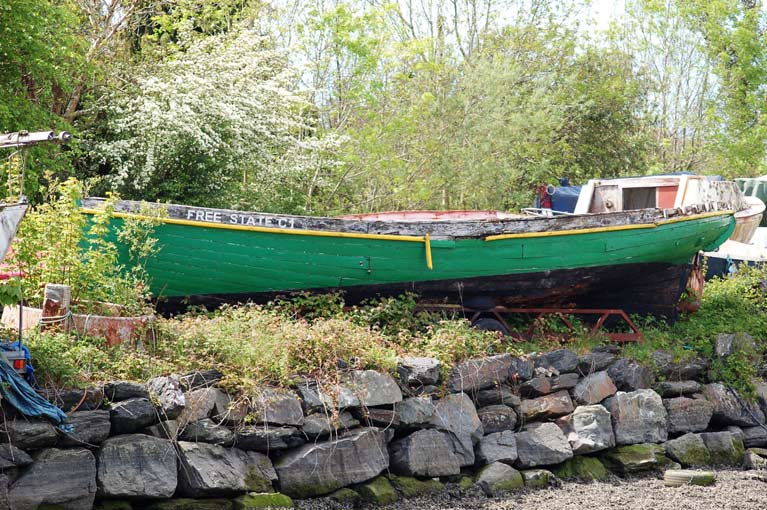 Free State C1 at Hegarty's Boatyard in Oldcourt Photo: Tom MacSweeney
Free State C1 at Hegarty's Boatyard in Oldcourt Photo: Tom MacSweeney
Back at Liam Hegarty’s yard, I came across a boat which had been built at Skinner’s and whose connections are historic to the founding of the Irish Republic.
Built in the style of a sailing boat, it became the first-ever boat to be registered as a fishing boat in County Cork, with a name that is outstanding – FREE STATE C1. So named because administrators of the emergent Irish State in 1922 apparently would not register it in Irish! So the family made their point with the unique name.
This is a story that has to be heard in the telling and was told to me by Eoin Ryan, himself a seafarer, whose family owns the boat that was “a super business venture in her time,” as he put it and also the first fishing boat, with sailing boat lines, built with an engine in place.
Listen to the podcast below
Now It’s The Rankin ‘Worlds’ at DinghyFest in Cork Harbour
There is satisfaction in being associated with a good news story about sailing, so the latest step in the Rankin dinghy development, which we have followed for four years on the Afloat website is the announcement that the revived, restored and re-energised fleet is to hold “the inaugural Rankin Worlds.”
They will be part of the ‘Cork Dinghy Fest’ in Cork Harbour in September.
The aim of the “Dinghy Fest” is to inject more fun into dinghy sailing, as Organiser Alex Barry told Afloat when plans for its third running were announced, with an on “keeping dinghy sailing classes alive,” by reaching out to all classes to take part and by encouraging young sailors.
"The classic fleet will be part of the ‘Cork Dinghy Fest’ in Cork Harbour in September"
He approached the Rankin Dinghy Class which has responded enthusiastically, “after all it is the dinghy class of the harbour,” Conor English, one of the leaders of the Rankin revival told me, putting emphasis on it being THE Cork Harbour dinghy class, with its historical association with boat-building in Cobh.
Planned in the schedule for the “Dinghy Fest,” are the National 18s National Championships; the Irish Multihull Nationals; the RS 200, 400 and Feva Southerns, the Mirror Southerns and the 29er Southerns. To these the Rankin ‘Worlds’ have been added.
Dinghy sailors have often told me that “friendship” is a key to keeping sailing classes going. That is well represented in the Rankin revival. Up to six of Rankins are racing weekly in Cove Sailing Club events and the Class says there are owners of the boats also in Dungarvan, Ardmore, Kinsale and Baltimore.
There is also a Rankin in Monkstown with the Barry family and Dinghy Fest Organiser, Alex, is an All-Ireland Sailing Champion and a member of both the RCYC and Monkstown Bay SC.
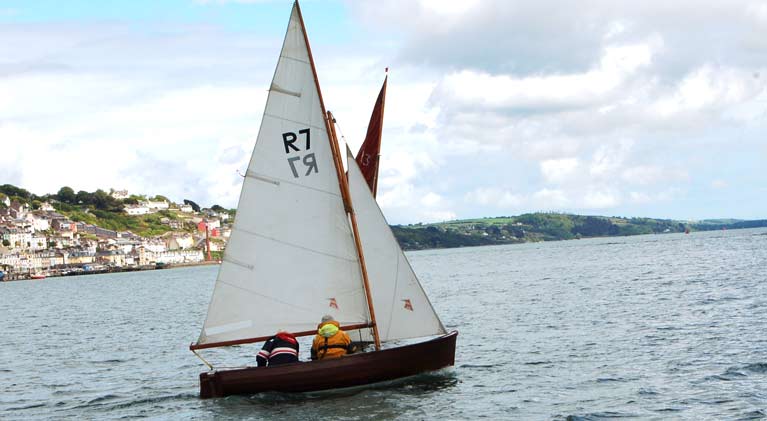 Port and starboard in a Rankin - we were in the right!
Port and starboard in a Rankin - we were in the right!
 Sailing in a Rankin to Crosshaven
Sailing in a Rankin to Crosshaven
I have sailed a Rankin, from Cobh to Crosshaven (!) as the photos show! After years out of dinghies and finding it easier to board a cruiser (!) it was an interesting experience!
The Rankins will race at the Dinghy Fest gathering on the weekend of Saturday and Sunday, September 14 and 15. Conor English tells me on my Podcast how the ‘Worlds’ have come about.
LISTEN TO THE PODCAST BELOW
“We’ll keep the tradition going. That’s the idea. We’ll carry on and keep traditional sailing going in Cork Harbour.”
So said Rory Allen who, with his son Gearoid, is the proud new owner of a much-travelled dinghy, the French” boat as it’s being called by the Rankin Class of owners, sailors and enthusiasts about Rankin boats, the revival of which we first reported in this Podcast on Afloat four years ago when interest was reawakened in the Rankin Dinghy, a boat with a great history in Cork Harbour, emanating from Cobh.
 Rankin class sailors at Whitepoint for the presentation of the two Rankins
Rankin class sailors at Whitepoint for the presentation of the two Rankins
Maurice Kidney and Conor English were the two men who drove that revival and Afloat was invited back to Whitepoint, just outside the town, to witness the latest stage in the remarkable progress of what they started as “a dream” as Maurice Kidney said to me.
“We’ll keep the tradition going. That’s the idea. We’ll carry on and keep traditional sailing going in Cork Harbour.”
This occasion was the handing over of two Rankins to their new owners. The “French” boat had been returned to Cork from France by ferry, the other boat had been recovered from Kinsale.
 Maurice Kidney one of the men who has led the Rankin revival
Maurice Kidney one of the men who has led the Rankin revival
The “French” Rankin has also been to Wexford, London and Donegal.
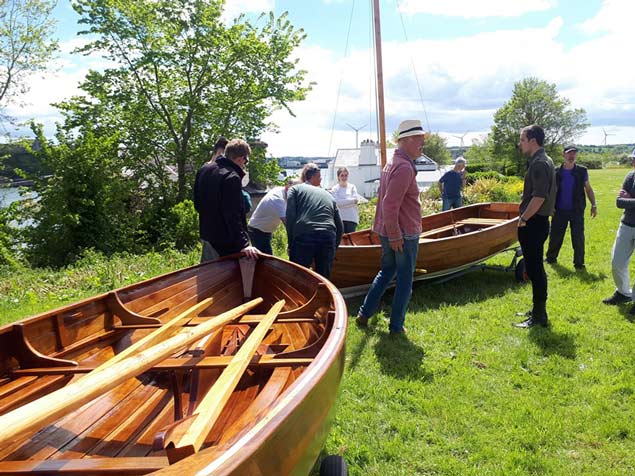 The Rankin recovered from Kinsale in the foreground and The 'French' boat
The Rankin recovered from Kinsale in the foreground and The 'French' boat
“There’s many seamiles clocked up on this one,” said Roddy Cooke, who once owned her. He worked previously with London Port and with BIM and is now at the Maritime College in Cork.
From the start of their revival of the boats built by the Rankin brothers in Cobh, the Class has now got to the stage where 25 Rankins are “available to sail,” said Maurice. “Our effort is to get them all out on the water. We also have a development programme going of converting Rankin punts to sailing.”
 Conor English (on left of picture) with the owners of The 'French' Boat - Rory Allen and his son Gearoid
Conor English (on left of picture) with the owners of The 'French' Boat - Rory Allen and his son Gearoid
“During the past two Winter seasons, Rankin punts have been repaired and converted to sailing, other Rankins have been located by the group,” Conor English said “and they all add to our growing numbers on the water. The aim is fun in sailing, rather than racing, though they can race as well, but a simple, family-friendly itinerary of events is what we plan.”
“This is for my sons too and then onto our grandsons, so we will pass this boat on from generation to generation,” said Johnny Hudson the new owner who was given possession of the Rankin brought back from Kinsale to Cork Harbour at the gathering in Whitepoint. “This is sailing, but also education in the history and the heritage of the harbour which we are really being asked to mind for the future in these boats and we will do that,”
It was a very special occasion, a true example of restoring older boats, recognising that what is old is not necessarily to be forgotten, but can be turned into a sailing attraction for new generations.
To get the atmosphere and flavour of the occasion, listen to my Podcast below, with the voices and the sounds of the Rankins.
Welcome to my new series of MacSweeney Podcasts on Afloat, in which I’ll be reporting on sailing and all to do with the culture, history, tradition and development of maritime Ireland.
These short Podcasts, about five minutes duration, will partner the fortnightly broadcast of my This Island Nation programme also here on Afloat, giving readers and listeners a shorter account of the maritime stories which catch my attention.
This week I’m podcasting dinghies, having sailed in one for the first time in 30 years and I am told why you should consider your automatic, gas-inflated lifejacket, in the same way as you would a parachute... Check it and make sure it is maintained....CH Marine says it is servicing 800 of them a month now, which shows that leisure sailors are concerned about their personal safety, which is the message Irish Water Safety is also conveying.
If, despite care, you get into trouble while swimming, the RNLI surprised me a little when they suggested that you should stop fighting the danger you find yourself in and try floating to safety instead.... When you hear how to do it, that’s good, specific advice to be followed.
The dinghy I sailed in was a Rankin, across Cork Harbour and it was a cracking sail. I thoroughly enjoyed it. It’s great to see old boats looked after and returned to the water for sailing.
So now... click below and listen to the Podcast.... In about five minutes you’ll benefit from the safety advice and enjoy the dinghy...
Win a Crewsaver Ergofit Pro Lifejacket Worth €205 In This Free To Enter CH Marine/Afloat.ie Competition here
There are 158 Deputies in the Dáil, elected by the people of Ireland. The Naval Service is the maritime defence force. Just two of those Deputies have shown direct interest in the “strategic implications for the State” threatening the Navy which I identified in this Podcast three weeks ago. That is associated with the proposal to build a hazardous waste incinerator at Ringaskiddy in Cork Harbour, close to the Naval Base. I have Emailed every political party in the Oireachtas and the Independent members, asking for their views on those “strategic implications,” identified by the Department of Defence. Scroll down to listen to this week's podcast below.
Deputy Tommy Broughan, Independent T.D. for the Dublin Bay North Constituency is the only TD who replied to me personally. He raised the matter with the Minister of State who has special responsibility for defence matters.
Fianna Fail’s Press Office replied with a comment from their Leader Micheál Martin, the only other TD to respond to my queries. He said that “Fianna Fáil is opposed to the plan to construct an incinerator at Cork Harbour,” that he believes “the plan is fundamentally flawed” and that the “intervention by both the Irish Naval Service and Air Corps is significant. “ He said he included some of their concerns in his statement to the Bord Pleanala public hearing.
Excluding the Ceann Comhairle because of his position, why have the rest of the TDs in the Dáil, including Ministers, not expressed concern or raised for discussion in the national parliament, the issue identified by the Department of Defence as: “Haulbowline is the Naval Service’s only base in Ireland…..an important strategic location for the Irish Defence Forces, with aviation activities performed there, including marine counter terrorism, joint Naval Service/Air Corps exercises including simulated attack, cargo slinging for replenishment of ships at sea … and so on…. Restrictions on the Irish Air Corps’ ability to operate with the Naval Service at Haulbowline is not just a local issue, but carries strategic implications for the State….” That is what the Department of Defence said in their statement to the Bord Pleanala public hearing.
Surely such a statement merits national attention, but it seems that the national planning board, Bord Pleanala, not the elected representatives of the people in the national parliament, will decide on those “strategic implications for the State.”
What does this say about maritime interest or concern amongst the members of Dáil Eireann?
Minister of State with responsibility for defence matters Paul Kehoe’s reply to Deputy Broughan was: “Dear Tommy, I wish to acknowledge receipt of your recent e-mail correspondence regarding the Naval Base at Haulbowline, Cork. I will be in touch with you again soon in relation to this matter.”
I Emailed the following questions to Minister Kehoe at [email protected] because the Taoiseach assigned special responsibilities for Defence to Minister Kehoe.
1 - What is the Government's attitude to the defined threat to the Naval Service/Air Corps operations? 2- Is the Government prepared to accept that an industrial project can compromise Naval Service/Air Corps operations? 3 - Is it conceding to Bord Pleanala the right, through a planning application, to decide on the operations of the Naval Service/Air Corps?
Up to the time of this Podcast and despite a reminder sent yesterday to the Press Office, no reply. I also Emailed Minister Kehoe’s constituency office. No reply.
Sinn Fein’s Senator Pádraig MacLochlainn, formerly Spokesman on Defence, sent my query onto Aengus O'Snodaigh TD who is now the party’s Spokesperson on Defence. I Emailed Deputy O’Snodaigh myself. No reply.
The Labour Party undertook to make a reply when a Spokesman on Defence is appointed.
As I have said before, I live in Cork Harbour and, from my home see three wind turbines powering chemical factories close by, hear and at times smell the operations of some of these plants every day, plus the noise of operations at Cork Port’s Ringaskiddy Deepwater Terminal, so I am well used to the heavy industrialisation of the harbour. This issue, however, is about strategic national implications for the State. In the midst of all the discussion about drugs, drug trafficking and the resultant gang war in Dublin, the importance of the Naval role in drugs interdiction should not be forgotten.
When I interviewed the Managing Director of Indaver, which is proposing the incinerator, he spoke of “compromise” with the Navy and Air Corps and equated waste management as being an important concern for the State, as well as the Naval Service.
I disagreed with him on any such equation of the Naval Service and disagreed that the nation’s maritime defence force and the Air Corps should have to make any compromise with an industrial concern, irrespective of that concern’s self-perceived importance to the country in waste management terms.
However, it seems to me that the majority of TDs in the Dáil could show more concern about the day-to-day operations of the Air Corps and Naval Service.
I have never sailed a Laser. The 13ft. dinghy’s closeness to the surface of the water exposes the occupant without much protection to the elements. But I admire those who sail the boat. They are a hardy bunch to whom I have information to impart this week which may be useful to Laser sailors - a garden mat is a vital piece of equipment if you are sailing the boat for long periods!
That piece of advice was given to me by a Dublin sailor who is on the North/West coast of Ireland around Mayo/Donegal this week – on a Laser circumnavigation which he has been sailing for long hours each day since the middle of May. Scroll down the page to listen to the podcast.
Gary Sargent, who tells me that he is also known in the sailing world as ‘Ted,’ is from Clontarf Yacht and Boat Club on the capital’s seafront, a club where I have had the pleasure of meeting members a few times. Being on a Laser this is a solo circumnavigation of Ireland, which he started from Schull in West Cork and to where he hopes to get back by the end of this month.
I have admiration for those who undertake amazing, challenging tasks. I’m not sure I could do the same and definitely not on a Laser dinghy, being an open boat with a single sail, low on the water with little freeboard and so not a lot of comfort, which is where the garden mat comes in!
You can hear Gary explain why he has already used three of them on this week’s THIS ISLAND NATION Podcast below.
“One wild ride” around Ireland is how he, rather fittingly, describes his voyage which he says, shows that there is “more to the sport of sailing than just racing.” He is hoping to raise the profile of the sport to newcomers and that is appropriate as the ISA’s ‘Try Sailing Project’ and ICRA’S ‘Crew Point’ initiative gets rolling at clubs around the coast this Summer.
“I have taught adult sailing for the last twelve-to-fourteen years. There is a wonderful satisfaction in encouraging people who have not previously been involved in the sport, watching their faces light up with the enjoyment of being on the water when they realise that sailing is easy and enjoyable. Literally, their lives change when they get close to the water. This trip is highlighting sailing as a sport. There is a world of sailing out there, more than just racing. If we put fun back into sailing it will go a long, long way towards widening its appeal.”
I talked to Gary when he arrived in Belmullet, Co. Mayo. “I started in Schull to get the toughest part of the voyage, along the West Coast, over first. I have a lot of experience on the East Coast and appreciate that the North and South coasts can be difficult, but the vast expanse of the West Coast has been daunting,” he said.
Gary is accompanied by friends on a 9-metre rigid inflatable as safety boat and they spend each night ashore. The support he has received from coastal communities on his voyage has, he says, been “a revelation and a lesson in what community spirit means.”
“They have been wonderful. It is an indication of how special Ireland’s coastal communities are, how they have welcomed and supported us. It is something I will never forget.”
He is also fundraising on his voyage for ChildVision, the organisation which supports and teaches children suffering from sight loss and other profound disabilities to reach their full potential in life.
- Listen to Gary below
There is more to sailing than racing, such as enjoyment, fun, cruising and bringing people together to enjoy each other’s company and the boats they sail. When those boats are dinghies that have a proud history and which a dedicated group of enthusiasts is determined to protect and develop, there is something special about the boats, the people and their interest in sailing.
Next Sunday facets will be brought together when the Rankin dinghies gather at Whitepoint, a promontory near the Cork Harbour town of Cobh where the town’s sailing club has been active for many years.
The boats that will be the focal point at half-past ten on Sunday morning will be Rankins, a dinghy which was built in Cobh, of which it’s believed there were 80 and of which The Rankin Dinghy Group has traced nearly half, one with a unique name linking a historic gun boat that unusually fought both for and against the Irish and a man who crewed on it, on both sides! It’s an intriguing story.
Enthusiasts who preserve boats are special people as far as I am concerned and I admire them. They are single-minded and dedicated. That dedication can come from admiration of a particular type of boat, of the man or men who built it, how it performs and often because they have been involved with the class of boat themselves and are seeking to avoid its decline and restore it to appreciation by more people.
The name of the Rankin dinghies is revered in Cork Harbour and particularly in the harbourside town of Cobh. And the name of one of those boats links the gunboat which fought against the Irish Volunteers during the 1916 Easter Rising and later for the emergent Irish Free State Government against anti-Treaty Forces during the Irish Civil War. It also links the renowned boat-building Rankin family in Cobh, one of whose members crewed on the gunboat.
Listen to the Podcast below in which I talk to two dedicated sailing enthusiasts, Maurice Kidney and Conor English, who are driving the restoration of the Rankin dinghies in Cork Harbour. They have discovered that Rankins were bought and sailed in several parts of the country.
You will hear how the name of the gunboat which shelled Liberty Hall during the Easter Rising of 1916, Helga, is maintained on a dinghy in Cork Harbour. How that gunboat, having fought against the Irish Volunteers, later fought for the emergent Irish Free State and became the first Irish fisheries protection vessel, Muirchu.
It’s a fascinating story about a special type of boat that The Rankin Dinghy Group is reviving. Having traced half the 80 boats which were built, the Group is asking anybody with information on the whereabouts of Rankin boats in any condition to contact Maurice Kidney on phone 086 3225424 or Conor English on phone 086 3531122.
• Listen to Podcast below. An article on the Rankins by Tom MacSweeney will also appear in Summer Afloat magazine
See a slideshow on the Rankin dinghy here



























